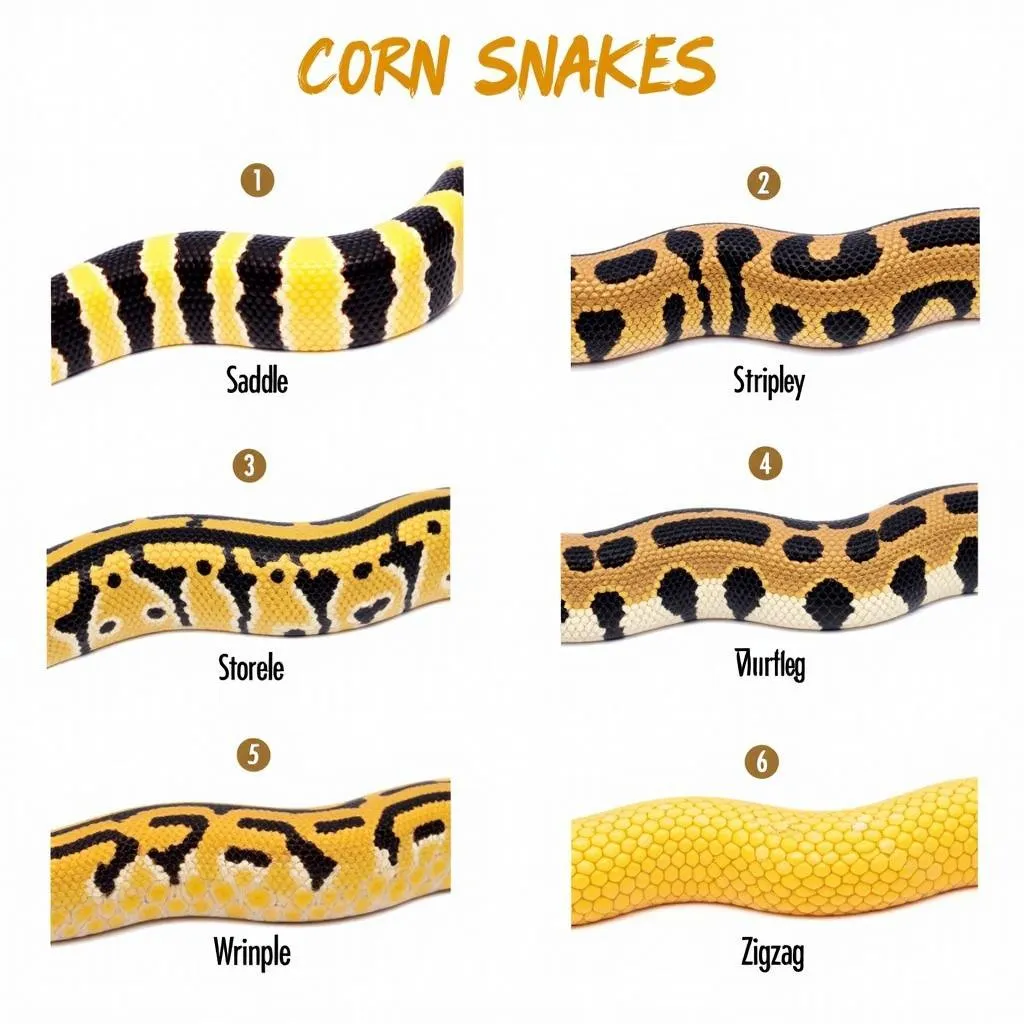The corn snake, a popular pet choice for reptile enthusiasts, is known for its docile nature and striking appearance. But what color is a corn snake, exactly? While the name might conjure images of a single hue, these captivating creatures boast a surprising array of colors and patterns.
Decoding Corn Snake Colors: More Than Meets the Eye
Corn snakes are not limited to a single shade. Their base color, often a reddish-brown, serves as a canvas for a mesmerizing array of patterns and markings. These variations, often referred to as “morphs,” are the result of selective breeding that enhances specific genetic traits.
A Rainbow of Morphs: Exploring the Variations
From the classic “Normal” morph with its reddish-brown saddles to the striking “Amelanistic” morph lacking black pigment, the world of corn snake colors is incredibly diverse. Here’s a glimpse into some popular morphs:
-
Amelanistic: These snakes lack black pigment, resulting in a vibrant orange or red base with contrasting markings in shades of brown or red.
-
Anerythristic: This morph lacks red pigment, creating a predominantly gray or silver snake with black or brown markings.
-
Snow: A combination of Amelanistic and Anerythristic genes, Snow corn snakes are a stunning white or cream color with faint pink or yellow markings.
-
Lavender: As the name suggests, this morph exhibits a beautiful lavender hue, often combined with pink or gray tones.
-
Caramel: Caramel corn snakes boast a warm brown base color with caramel-colored markings, creating a rich and inviting appearance.
Beyond Color: Patterns and Markings
Adding to their visual appeal, corn snakes also exhibit a variety of patterns and markings. These patterns, often inherited alongside color morphs, create intricate and unique designs on each snake. Some common patterns include:
- Saddle: Characterized by dark, saddle-shaped markings along the back.
- Striped: As the name implies, these snakes display stripes running the length of their bodies.
- Motley: This pattern disrupts the normal saddle pattern, creating a more scattered and irregular appearance.
- Zigzag: A visually striking pattern featuring a continuous zigzag stripe along the back.
 Corn Snake Patterns
Corn Snake Patterns
Why So Colorful? The Role of Color in the Wild
The vibrant colors and patterns of corn snakes serve a crucial purpose in their natural environment. Primarily found in the southeastern United States, these non-venomous snakes rely on camouflage to avoid predators and ambush prey.
- Blending In: Their natural reddish-brown coloration helps them blend seamlessly into leaf litter and wooded areas.
- Disruptive Patterns: Bold markings, such as saddles or stripes, can break up the snake’s outline, making it harder for predators to spot them.
The Allure of Corn Snake Colors
The remarkable diversity of corn snake colors and patterns has captivated reptile enthusiasts for generations. Whether drawn to the fiery hues of an Amelanistic morph or the subtle elegance of a Lavender corn snake, there’s a color and pattern combination to fascinate every snake lover.
Corn Snake Colors: A Testament to Genetic Diversity
The stunning array of colors found in corn snakes is a testament to the power of genetic diversity. Through selective breeding, breeders have unlocked a spectrum of colors and patterns, making each corn snake a unique and captivating creature.
“The beauty of corn snakes lies not just in their individual colors, but in the endless possibilities that arise from combining different genetic traits,” says Dr. Emily Carter, a herpetologist specializing in reptile genetics. “Each new morph is a testament to the incredible diversity hidden within their DNA.”
Caring for Your Colorful Companion
No matter the color or pattern, providing proper care is essential for the health and well-being of your corn snake. This includes:
- A spacious enclosure with appropriate heating and humidity levels.
- A balanced diet of appropriately sized prey items.
- Regular cleaning and maintenance of their living environment.
Embracing the Colorful World of Corn Snakes
From the classic beauty of a “Normal” morph to the striking appearance of a “Snow” corn snake, these reptiles offer a mesmerizing glimpse into the world of color and pattern. Whether you’re a seasoned snake owner or a curious beginner, the vibrant world of corn snakes is sure to captivate your imagination.
FAQs about Corn Snake Colors
Q: Do corn snake colors change over time?
A: While their colors don’t drastically change, they may become more vibrant or subdued depending on factors like shedding cycles and lighting.
Q: Are certain corn snake colors rarer than others?
A: Yes, some morphs, especially those resulting from complex genetic combinations, are rarer and may be more expensive.
Q: Can I breed corn snakes to produce specific colors?
A: Breeding corn snakes for specific colors and patterns requires knowledge of genetics and responsible breeding practices.
Q: Do corn snake colors affect their temperament?
A: No, color morphs primarily affect appearance and do not influence a corn snake’s personality or behavior.
Q: What is the most popular corn snake color?
A: The classic “Normal” morph with its reddish-brown saddles remains a popular choice, but preferences vary widely among snake enthusiasts.
Need Help Choosing the Right Color for You?
Choosing the perfect corn snake can be an exciting decision. Contact us at [Phone number] or email us at [email address]. Our team at Color Box Hà Nội is here to guide you through the world of corn snake colors and help you find the perfect companion. Visit us at our Hà Nội location: [Address]. We’re available 24/7 to answer your questions and help you find the snake of your dreams.

